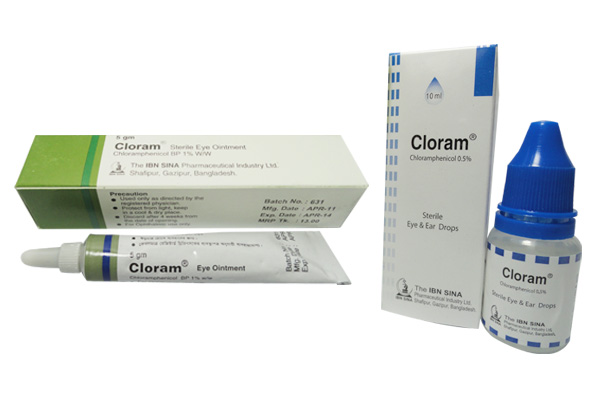
CLORAM
CHLORAMPHENICOL BP
| NAME | STRENGTH | PACK SIZE | DOSAGE FORM |
|---|---|---|---|
| CLORAM 0.5% W/V | 0.5% W/V | 10 ML | EYE DROP |
| CLORAM 1% W/W | 1% W/W | 5 GM | EYE OINTMENT |
Cloram Eye/Ear Drops: Each ml contains Chloramphenicol BP 5 mg. Cloram eye Ointment: Each gm contains Chloramphenicol BP 10 mg.
Cloram (Chloramphenicol) Eye/Ear Drops is 0.5% ophthalmic and otic antiinfective sterile solution of Chloramphenicol. Cloram Eye ointment is 1 % ophthalmic anti-infective sterile ointment of Chloramphenicol.Chloramphenicol is a potent, broad spectrum antibiotic and is effective against a wide range of gram-positive and gram-negative organisms. The drug is bacteriostatic and interferes with protein synthesis. It penetrates cornea, conjunctiva and into the aqueous humor of eye and excreted by the nasolacrimai system. Chloramphenicol also inhibits or destroys the bacteria present in ear canal. The drug begins to act within one hour.
Eye drop: Because of its wide range of antibacterial spectrum Cloram Eye Drops and Eye Ointment are used in a variety of infections caused by sensitive organisms such as: conjunctivitis, blepharitis, corneal ulcer, dacryocystitis etc. Ear drop: Cloram ear drops is indicated in external ear canal infection.
Eye drop: 2 drops of solution in eye every 3 hours or more frequently if required. Ear drop: 2 to 3 drops into ear canal three or four times daily. Administration should be continued for 48 hours after symptoms have been disappeared. Eye ointment: One application of ointment to lower conjunctival sac every 3 hours or more frequently if required.
Chloramphenicol is contraindicated in patients with a history of hypersensitivity or toxic reaction to it.
Chloramphenicol should never be given for minor infections or for prophylaxis. Repeated courses and prolonged treatment should be avoided. If discharge is profused, the ear canal should be carefully cleaned and a quarter inch gauze impregnated with the ear-drops should be introduced.
Systemic adverse reaction has not been reported with short term topical use of Chloramphenicol. Rarely, optic atrophy in children, stinging and burning of the eye in patient sensitive to Chloramphenicol may be experienced.
The Australian categorisation definition of: Category A: Drugs which have been taken by a large number of pregnant women and women of childbearing age without any proven increase in the frequency of malformations or other direct or indirect harmful effects on the fetus having been observed. Systematically absorbed/administered forms of chloramphenicol enter the foetal circulation and are distributed into breast milk. If given systematically to the mother shortly before parturition or whilst breastfeeding, chloramphenicol may cause bone marrow suppression of the neonate or the “grey baby syndrome”, characterised by cyanosis and hypothermia, owing to the limited glucuronidating capacity of the neonate’s liver. However, limited absorption following ophthalmic use at the recommended dosage is generally not expected to pose a risk to the foetus or neonate.
Accidental ingestion of the drug is unlikely to cause any toxicity due to low content of antibiotic. Cloram ED contains 18.80 mg/mL of borax/boric acid as buffer with less than 0.13 mg/mL of sodium hydroxide. If the eye drops are accidentally ingested by infants or young children, Poisons Information Centre (Telephone 131126) should be contacted. The medication should be kept out of reach of children.
Accidental ingestion of the medicine is unlikely to cause any toxicity due to low content of antibiotic.
Store in a cool (between 2°C-8°C) and dry place, protect from light, keep out of reach of children. Do not touch the dropper tip to the surface since this may contaminate the solution. Do not use after 30 days of the first opening.
Cloram Eye/Ear Drops: Dropper bottle contains 10 ml sterile drops. Cloram eye ointment: Tube contains 5 gm sterile ointment.
